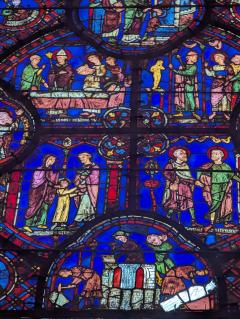 Today was a little more stressful because we had some miles to cover and things that we much desired to see, but we also had 5:00 PM time-entry tickets for Versailles. We got a slow start and had to abandon our plan to see Chambord in favor of sufficient time in Chartres, and I really wanted to see Illiers-Combray on the way there. Fortunately everything worked out and we saw everything that we wanted to see.
Today was a little more stressful because we had some miles to cover and things that we much desired to see, but we also had 5:00 PM time-entry tickets for Versailles. We got a slow start and had to abandon our plan to see Chambord in favor of sufficient time in Chartres, and I really wanted to see Illiers-Combray on the way there. Fortunately everything worked out and we saw everything that we wanted to see.
The Loire is one of the great rivers of France. It flows through vineyards and past some beautiful and famous chateaus. It was a nice way to start the day before we had to turn to the Northeast to head toward Chartres, Versailles, and Paris. On the way to Chartres, and ancient and important market center for the region, I really wanted to get to the little town of Illiers-Combray, a suburb of Chartres, as the next step in my Proust Itinerary. Proust selected sleepy Illiers as the setting for the first book of his sprawling novel, Swann's Way, in which he refers to his fictionalized version of the town as Combray. Nowadays Illiers goes by the name Illiers-Combray, and Proust is everywhere.
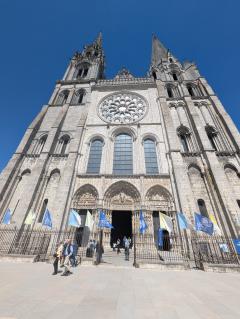 In Swann's Way, the narrator starts as the grown man who, over a cup of tea and a madeleine, is reminded of the flavors and other sensations of his youth. This opens the sprawling novel, and the rest of the book is told by the narrator as a young boy. He goes for walks and explores the countryside in two ways, the walk by M. Swann’s grand house, that he calls Swann's Way, and heading in the other direction, by the grander home of the Guermantes, that he calls The Guermantes Way, the title of the third book (in between, the second book takes place at the Grand Hotel in Cabourg, which we saw on Day 2). On market days, his grandmother takes him into Chartres, where he spends hours admiring, exploring, reading about, and reflecting upon the ancient and beautiful cathedral there. The Combray of the young boy, now embodied in the modern town of Illiers-Combray, has naturally changed in the 135 years since the setting of the novel, and the memories of a preteen boy are a poor guide in any event; it was my object only to see the countryside of his peregrinations and to reconstruct in my mind what I could of the stories. We did not go into the Proust Museum and Gift Shop.
In Swann's Way, the narrator starts as the grown man who, over a cup of tea and a madeleine, is reminded of the flavors and other sensations of his youth. This opens the sprawling novel, and the rest of the book is told by the narrator as a young boy. He goes for walks and explores the countryside in two ways, the walk by M. Swann’s grand house, that he calls Swann's Way, and heading in the other direction, by the grander home of the Guermantes, that he calls The Guermantes Way, the title of the third book (in between, the second book takes place at the Grand Hotel in Cabourg, which we saw on Day 2). On market days, his grandmother takes him into Chartres, where he spends hours admiring, exploring, reading about, and reflecting upon the ancient and beautiful cathedral there. The Combray of the young boy, now embodied in the modern town of Illiers-Combray, has naturally changed in the 135 years since the setting of the novel, and the memories of a preteen boy are a poor guide in any event; it was my object only to see the countryside of his peregrinations and to reconstruct in my mind what I could of the stories. We did not go into the Proust Museum and Gift Shop.
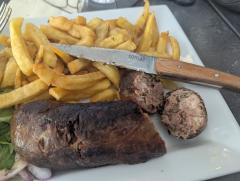 In Chartres, we had lunch, explored the cathedral, and did a little shopping, ever mindful of our schedule.
In Chartres, we had lunch, explored the cathedral, and did a little shopping, ever mindful of our schedule.
Lunch was (for me) Pâtè en Croute Richelieu, Oeuf Meurette (a poached egg in a red wine sauce with pork), and my first exposure to the Breton traditional Andouillette, a very coarse sausage made from the large intestine of pork stuffed with chopped small intestine and wine and seasoned with pepper, onions, and other seasonings that depend upon the region. It's an offal dish, and an iconic dish all over France, but it would be too much to call it widely loved. Even Stanley Tucci didn't care for it! But I'd be no kind of foodie explorer to miss the opportunity to try this icon of French cuisine!
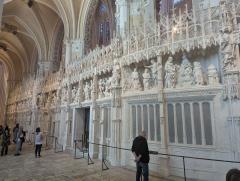 The cathedral is magnificent! It was crowded and busy, and there was a mass going on in one of the side chapels where we had to be respectful. I was especially impressed by the amazing stonework, particularly an enormous frieze of white marble that extended for much of the length of the interior. The stained glass windows were wonderful, and the paintings on some of the walls. We entered through a side entrance and made our way around the interior and to a nice gift shop near the front entrance. As at Carnac, there were many books, and a good number of them were available in English as well as in French. Afterward I stood outside examining the exterior and it was easy to see how the little boy from Combray could have spent so many hours here, it's like reading a good book!
The cathedral is magnificent! It was crowded and busy, and there was a mass going on in one of the side chapels where we had to be respectful. I was especially impressed by the amazing stonework, particularly an enormous frieze of white marble that extended for much of the length of the interior. The stained glass windows were wonderful, and the paintings on some of the walls. We entered through a side entrance and made our way around the interior and to a nice gift shop near the front entrance. As at Carnac, there were many books, and a good number of them were available in English as well as in French. Afterward I stood outside examining the exterior and it was easy to see how the little boy from Combray could have spent so many hours here, it's like reading a good book!
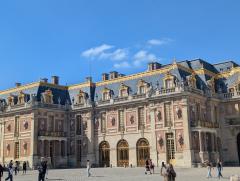 After Chartres we had to make tracks to Versailles for our timed-ticket entry. The highway was fast and moderately congested, but it was a Sunday afternoon. As we got closer to Paris, it became more and more like any other city that we drive through. Along the way I finally succeeded in getting a cup of ice at a Burger King. Ice is ridiculously hard to come by in Europe.
After Chartres we had to make tracks to Versailles for our timed-ticket entry. The highway was fast and moderately congested, but it was a Sunday afternoon. As we got closer to Paris, it became more and more like any other city that we drive through. Along the way I finally succeeded in getting a cup of ice at a Burger King. Ice is ridiculously hard to come by in Europe.
Parking and entry were not too difficult, but it helped having extra eyes in the car to spot important signs in unexpected locations.
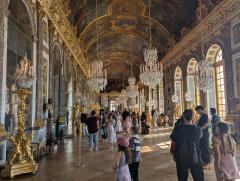 Versailles palace is huge, and expanses of it glitter with gold leaf. It is quite imposing and impressive when you see it for the first time. It is a beautiful place and we walked our feet off, but in the end we were unanimous that the Schönbrunn Palace did a better job of presenting the history and the people. For example, there was nothing about where the Treaty of Versailles was signed (In the Hall of Mirrors, in the photo here). It may have been in the audio tour, but (as in the rest of France) there should have been more signage. The gift shop was closed as we left, and we never did find water or food.
Versailles palace is huge, and expanses of it glitter with gold leaf. It is quite imposing and impressive when you see it for the first time. It is a beautiful place and we walked our feet off, but in the end we were unanimous that the Schönbrunn Palace did a better job of presenting the history and the people. For example, there was nothing about where the Treaty of Versailles was signed (In the Hall of Mirrors, in the photo here). It may have been in the audio tour, but (as in the rest of France) there should have been more signage. The gift shop was closed as we left, and we never did find water or food.
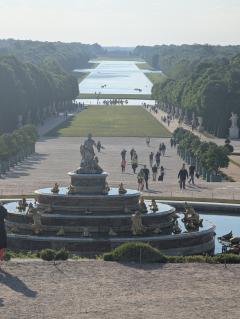 After shuffling though the interior, we made it out to the grounds, which are quite extensive and well-maintained. Melissa trekked down to the man-made pond down the hill on which Marie Antoinette used to boat, but Lorna and I were foot-weary so we people-watched from the stairs near the palace.
After shuffling though the interior, we made it out to the grounds, which are quite extensive and well-maintained. Melissa trekked down to the man-made pond down the hill on which Marie Antoinette used to boat, but Lorna and I were foot-weary so we people-watched from the stairs near the palace.
Something that we've discovered about European museums: they are staffed by regular employees who earn a modest living wage, and often know very little about anything in the museum. American museums rely heavily upon volunteers and low-paid students who have a passion for the subject; part of their compensation is the happiness they get surrounded by what they love, so they tend to be more helpful to tourists.
We had dinner at Au Bureau, near the Hotel Campanile Paris Ouest, Chaville, where we got much help from Adrianna in finding the restaurant, among other things. The dinner was ordinary fare, well presented. Mac and cheese, fish and chips, some sort of salad, and a trio of ice creams, no new ground in exploring la cuisine de France.
